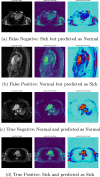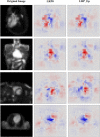Explaining decisions of a light-weight deep neural network for real-time coronary artery disease classification in magnetic resonance imaging
- PMID: 38348346
- PMCID: PMC10858933
- DOI: 10.1007/s11554-023-01411-7
Explaining decisions of a light-weight deep neural network for real-time coronary artery disease classification in magnetic resonance imaging
Abstract
In certain healthcare settings, such as emergency or critical care units, where quick and accurate real-time analysis and decision-making are required, the healthcare system can leverage the power of artificial intelligence (AI) models to support decision-making and prevent complications. This paper investigates the optimization of healthcare AI models based on time complexity, hyper-parameter tuning, and XAI for a classification task. The paper highlights the significance of a lightweight convolutional neural network (CNN) for analysing and classifying Magnetic Resonance Imaging (MRI) in real-time and is compared with CNN-RandomForest (CNN-RF). The role of hyper-parameter is also examined in finding optimal configurations that enhance the model's performance while efficiently utilizing the limited computational resources. Finally, the benefits of incorporating the XAI technique (e.g. GradCAM and Layer-wise Relevance Propagation) in providing transparency and interpretable explanations of AI model predictions, fostering trust, and error/bias detection are explored. Our inference time on a MacBook laptop for 323 test images of size 100x100 is only 2.6 sec, which is merely 8 milliseconds per image while providing comparable classification accuracy with the ensemble model of CNN-RF classifiers. Using the proposed model, clinicians/cardiologists can achieve accurate and reliable results while ensuring patients' safety and answering questions imposed by the General Data Protection Regulation (GDPR). The proposed investigative study will advance the understanding and acceptance of AI systems in connected healthcare settings.
Keywords: Classification; Explainable AI; Healthcare models; Hyper-parameter tuning; Time complexity.
© The Author(s) 2024.
Conflict of interest statement
Conflicts of interestAll authors declare that they have no conflict of interest.
Figures





Similar articles
-
Advanced interpretable diagnosis of Alzheimer's disease using SECNN-RF framework with explainable AI.Front Artif Intell. 2024 Sep 2;7:1456069. doi: 10.3389/frai.2024.1456069. eCollection 2024. Front Artif Intell. 2024. PMID: 39286548 Free PMC article.
-
EA-CNN: Enhanced attention-CNN with explainable AI for fruit and vegetable classification.Heliyon. 2024 Nov 30;10(23):e40820. doi: 10.1016/j.heliyon.2024.e40820. eCollection 2024 Dec 15. Heliyon. 2024. PMID: 39698093 Free PMC article.
-
An Explainable AI Paradigm for Alzheimer's Diagnosis Using Deep Transfer Learning.Diagnostics (Basel). 2024 Feb 5;14(3):345. doi: 10.3390/diagnostics14030345. Diagnostics (Basel). 2024. PMID: 38337861 Free PMC article.
-
Explainable AI for Bioinformatics: Methods, Tools and Applications.Brief Bioinform. 2023 Sep 20;24(5):bbad236. doi: 10.1093/bib/bbad236. Brief Bioinform. 2023. PMID: 37478371 Review.
-
Recent Advances in Explainable Artificial Intelligence for Magnetic Resonance Imaging.Diagnostics (Basel). 2023 Apr 27;13(9):1571. doi: 10.3390/diagnostics13091571. Diagnostics (Basel). 2023. PMID: 37174962 Free PMC article. Review.
References
-
- Brown, J. C., Gerhardt, T. E., Kwon, E.: “Risk factors for coronary artery disease,” 2020 - PubMed
-
- Knaapen, P.: “Computed tomography to replace invasive coronary angiography? close, but not close enough,” 2019 - PubMed
-
- Serruys PW, Hara H, Garg S, Kawashima H, Nørgaard BL, Dweck MR, Bax JJ, Knuuti J, Nieman K, Leipsic JA, et al. Coronary computed tomographic angiography for complete assessment of coronary artery disease: Jacc state-of-the-art review. J. Amer. Coll. Cardiol. 2021;78(7):713–736. doi: 10.1016/j.jacc.2021.06.019. - DOI - PubMed
LinkOut - more resources
Full Text Sources
